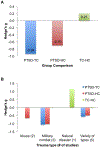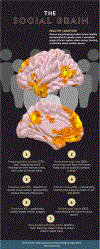Role of social cognition in post-traumatic stress disorder: A review and meta-analysis
- PMID: 30221467
- PMCID: PMC6342618
- DOI: 10.1111/gbb.12518
Role of social cognition in post-traumatic stress disorder: A review and meta-analysis
Abstract
Social functioning is a key component of recovery after a potentially traumatic experience, and the buffering role of the social support in trauma resilience and recovery has been very well documented. Factors contributing to resilience and recovery are notable because although most people will experience a traumatic event during their lifetimes, only 6% to 10% are diagnosed with post-traumatic stress disorder (PTSD). The relationship between an individual and their social environment is determined both by the quality of the social environment itself, and by the individual's perception and understanding of information conveyed by the other people around them. However, little research has considered the contribution of these internal social cognitive processes to PTSD risk or resilience. The current review draws on the existing literature on social cognitive functioning in trauma exposure and PTSD, identifying key questions and themes for future research. We utilized a meta-analytic approach to assess the evidence for alterations in social cognition in PTSD, finding a consistent large deficit in social cognitive performance in PTSD groups relative to trauma-exposed and healthy controls. We then reviewed the literature on the interaction of genes and the social environment, supporting the hypothesis that social cognitive deficits are a preexisting risk factor for PTSD. Finally, we reviewed relevant neuroimaging findings, which suggest that alterations in social cognition affect the perception of threat cues in PTSD. Overall, research on social cognition and PTSD is still emerging, but existing findings suggest this is an important and understudied area for the understanding of PTSD.
Keywords: G × SE; PTSD; fMRI; face stimuli; genetic risk; meta-analysis; neuroimaging; social brain; social cognition; trauma exposure.
© 2018 John Wiley & Sons Ltd and International Behavioural and Neural Genetics Society.
Conflict of interest statement
Conflict of Interest
The authors report no conflict of interest.
Figures


Similar articles
-
[Posttraumatic stress disorder (PTSD) as a consequence of the interaction between an individual genetic susceptibility, a traumatogenic event and a social context].Encephale. 2012 Oct;38(5):373-80. doi: 10.1016/j.encep.2011.12.003. Epub 2012 Jan 24. Encephale. 2012. PMID: 23062450 Review. French.
-
Psychobiology of the acute stress response and its relationship to the psychobiology of post-traumatic stress disorder.Psychiatr Clin North Am. 2002 Jun;25(2):385-95. doi: 10.1016/s0193-953x(01)00005-3. Psychiatr Clin North Am. 2002. PMID: 12136506 Review.
-
Social cognitive performance in posttraumatic stress disorder: A meta-analysis.J Affect Disord. 2022 Jan 15;297:35-44. doi: 10.1016/j.jad.2021.09.082. Epub 2021 Oct 1. J Affect Disord. 2022. PMID: 34606811 Review.
-
[Post-traumatic stress disorder in reaction to psychotic experience: A systematic revue].Encephale. 2019 Dec;45(6):506-512. doi: 10.1016/j.encep.2019.07.006. Epub 2019 Sep 11. Encephale. 2019. PMID: 31521338 French.
-
Social cognition in post-traumatic stress disorder: A systematic review.Br J Clin Psychol. 2020 Jun;59(2):117-138. doi: 10.1111/bjc.12238. Epub 2019 Nov 7. Br J Clin Psychol. 2020. PMID: 31696974
Cited by
-
The social cognitive appraisal of trustworthiness in individuals with dimensional levels of post-traumatic stress symptoms: a translational study.Eur J Psychotraumatol. 2019 Nov 29;10(1):1697582. doi: 10.1080/20008198.2019.1697582. eCollection 2019. Eur J Psychotraumatol. 2019. PMID: 31839901 Free PMC article.
-
Laboratory models of post-traumatic stress disorder: The elusive bridge to translation.Neuron. 2022 Jun 1;110(11):1754-1776. doi: 10.1016/j.neuron.2022.03.001. Epub 2022 Mar 23. Neuron. 2022. PMID: 35325617 Free PMC article. Review.
-
Assessing and Modelling of Post-Traumatic Stress Disorder Using Molecular and Functional Biomarkers.Biology (Basel). 2023 Jul 26;12(8):1050. doi: 10.3390/biology12081050. Biology (Basel). 2023. PMID: 37626936 Free PMC article. Review.
-
Stress-Related Brain Alterations in Chronic Pain.Eur J Pain. 2025 Jul;29(6):e70034. doi: 10.1002/ejp.70034. Eur J Pain. 2025. PMID: 40344274 Free PMC article.
-
Neurophysiology and Psychopathology Underlying PTSD and Recent Insights into the PTSD Therapies-A Comprehensive Review.J Clin Med. 2020 Sep 12;9(9):2951. doi: 10.3390/jcm9092951. J Clin Med. 2020. PMID: 32932645 Free PMC article. Review.
References
-
- Adolphs R (2003). Cognitive neuroscience of human social behaviour. Nat Rev Neurosci, 4(3), 165–178. - PubMed
-
- Andersen SB, Karstoft K-I, Bertelsen M, & Madsen T (2014). Latent trajectories of trauma symptoms and resilience: the 3-year longitudinal prospective USPER study of Danish veterans deployed in Afghanistan. J Clin Psychiatry, 75(9), 1001–1008. - PubMed
-
- Association, A. P. (2013). Diagnostic and statistical manual of mental disorders, (DSM-5®). Washington, D.C.: American Psychiatric Pub.
Publication types
MeSH terms
Grants and funding
LinkOut - more resources
Full Text Sources
Other Literature Sources
Medical

